
Spice-infused Masoor Dal Curry, prepared the Goan way. This comfort one-pot dish is all yours if you love warm and vibrant, nutritious lentil meals and food from Goa, India.

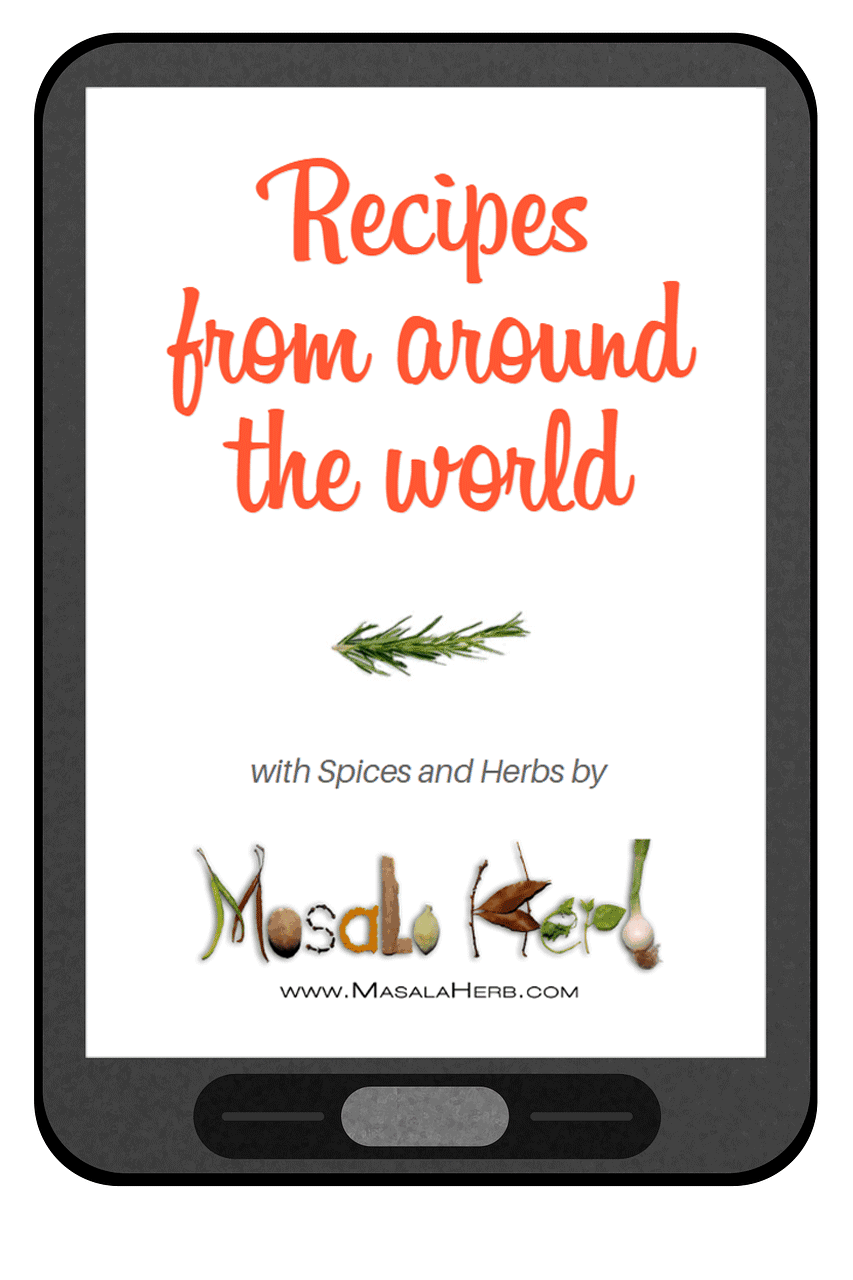
Global Food Recipes
with Spices and Herbs
Free E-Book available for a limited time. Grab yours now and get instantly inspired!
You missed out!
The post, Masoor Dal, was first published on the 12th August 2011 (it's one of the first recipes here!) and has been updated and enhanced ever since.
Jump to:
Overview
Masoor Dal is an Indian lentil dish prepared with orange-red lentils. The lentils are also known by the name masoor dal (मसूर दाल) in India. Dal is Hindi and means lentil, and some people mistakenly also spell them as dhal or daal.
You can get whole masoor dal or split masoor dal in stores, but the latter one cooks faster. When heated, the lentils turn yellow, but they are orange-red when dried.
Then there are also brown Masoor dal lentils, which are unpeeled whole orange-red masoor dal lentils. Just FIY these are not the ones that you will use in this recipe.
This particular masoor dal recipe is a Goan version. That means it's based on the way masoor dal is prepared in Goa. I'm saying based because several versions exist across this Western Indian state, and this is just one of them (my favorite version).
It's a great recipe for beginner cooks or those who want to get into Indian cooking. The lentils are also easy to cook through and digest, compared to other lentil varieties.

Ingredient Notes
- Masoor Dal — split or whole. I prefer split as they cook through faster and I like my Masoor dal well cooked through, thick and almost mushy.
- Water — For soaking and to top up lentil to cook.
- Onion — purple or red onions are normally used because that's what's most commonly available in Goa, India. But you can use white or yellow onions too.
- Tomato
- Oil — You can use either vegetable oil, sunflower oil or canola oil. I personally love cold-pressed quality mustard oil, but that's not something that they use traditionally.
- Brown or Red Mustard Seeds
- Curry Leaves — fresh, never dried. You can use frozen curry leaves too. (Curry leaves and curry powder are absolutely not the same thing).
- Ginger Garlic Paste — or garlic paste and ginger paste/grated, with ⅓ ginger and ⅔ garlic.
- Turmeric Ground
- Chili Pepper Ground — Here they generally use a Kashmiri chili variety in Goa which is milder and not that hot. You can also use cayenne pepper.
- Salt & Black Pepper
- Cumin Ground
- Coriander Seed Ground
- Asafoetida — aka Hing in India. Not a traditional ingredient but I have seen some people use it in dal and I love it as this gum spice intensifies flavors.
- Cilantro — Freshly chopped
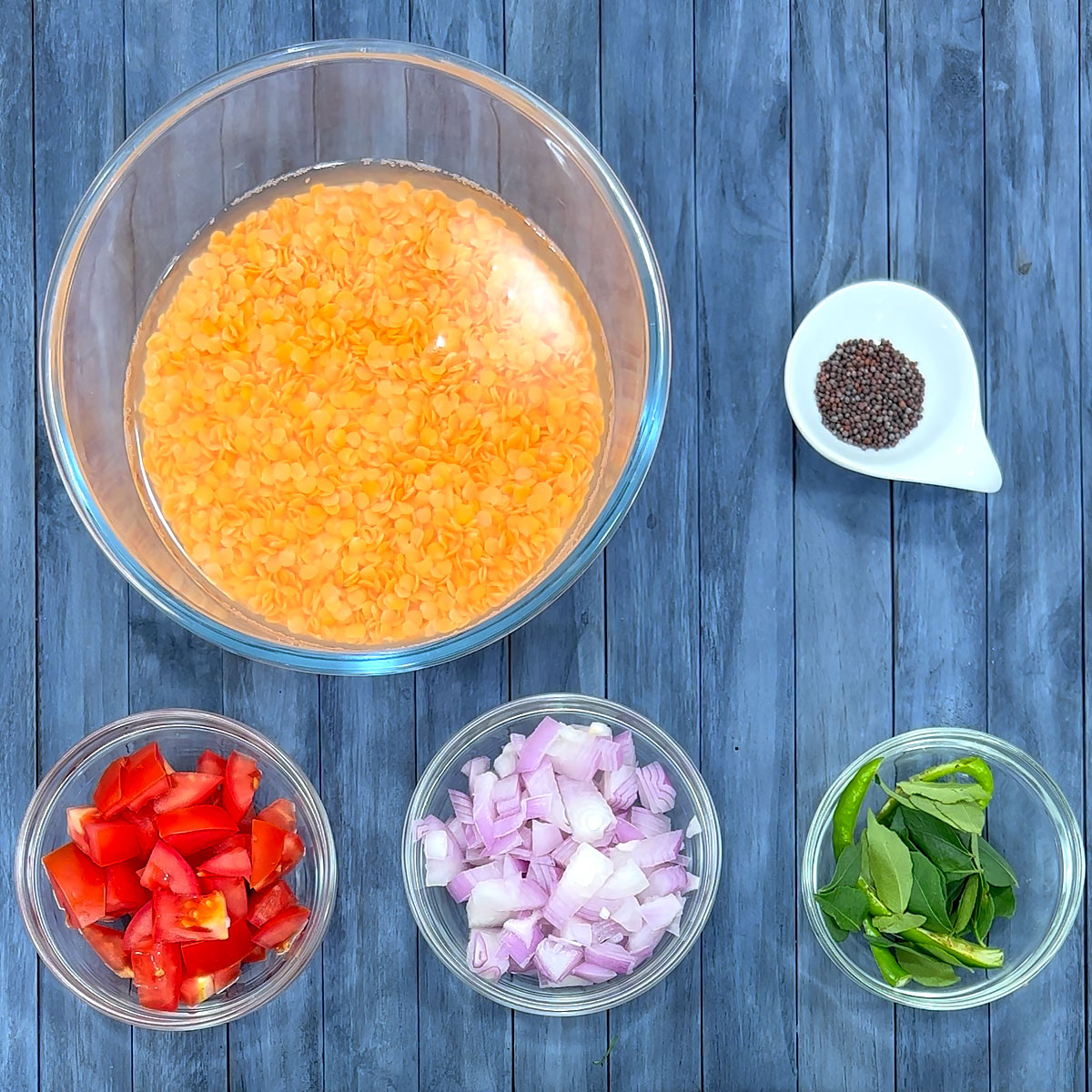

Additional Spices That You Can Add (Advanced)
I meal-prep lentil dal in the winter months weekly and as a result, I have tried variations by adding different ingredients to the dal. Most additions are spices and add a light sour element to the meal, which I absolutely love.
- Bilimbi Fruit — a sour fruit from the cucumber tree that they add to dal in Goa. Use 1 Fruit only.
- Dried Malabar Tamarind — delivers a sour fruity element to the lentil dish, and it's a bit unique in flavor. Use 1 piece only.
- Tamarind paste — Indian tamarind adds sour flavors, not to be confused with sweet Thai tamarind. Use 1 Teaspoon.
- Black Stone Flower (Kalpasi/Dagad Phool) — leafy fungi that grows on bark that is used as a spice to add earthy, unique flavors to South and Western Indian foods. It is definitely unique and only for advanced spice users. Use about 1 piece, the size of a finger nail.
- Dried Green Mango Powder (Amchur) — easy to mix in sour fruity flavors. Use just a pinch.

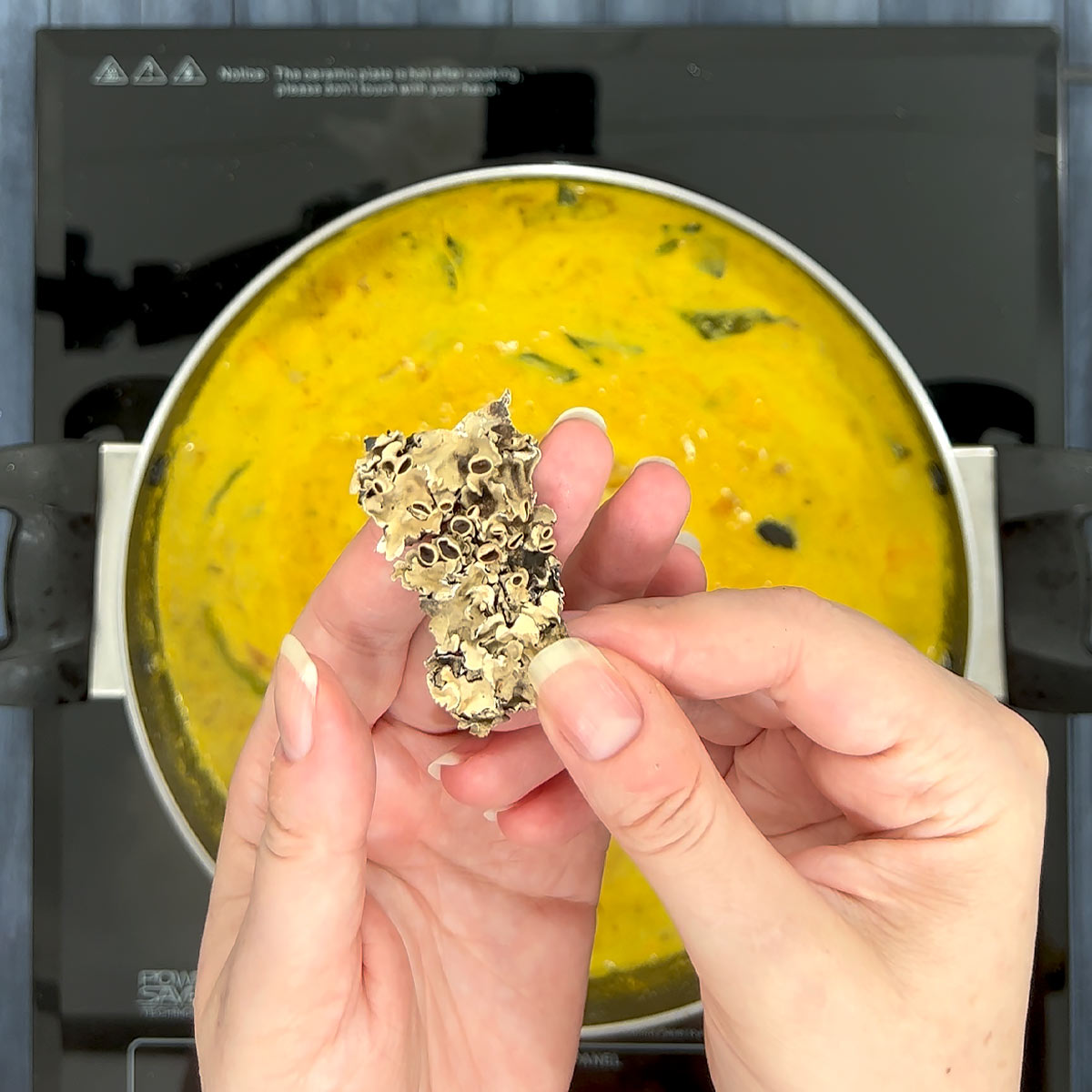
Process Overview
Step 1
Wash lentils in clear water.
Soak lentils for 10–20 mins to speed up cooking time and so that the lentils are easier to digest. Just cover with enough water.

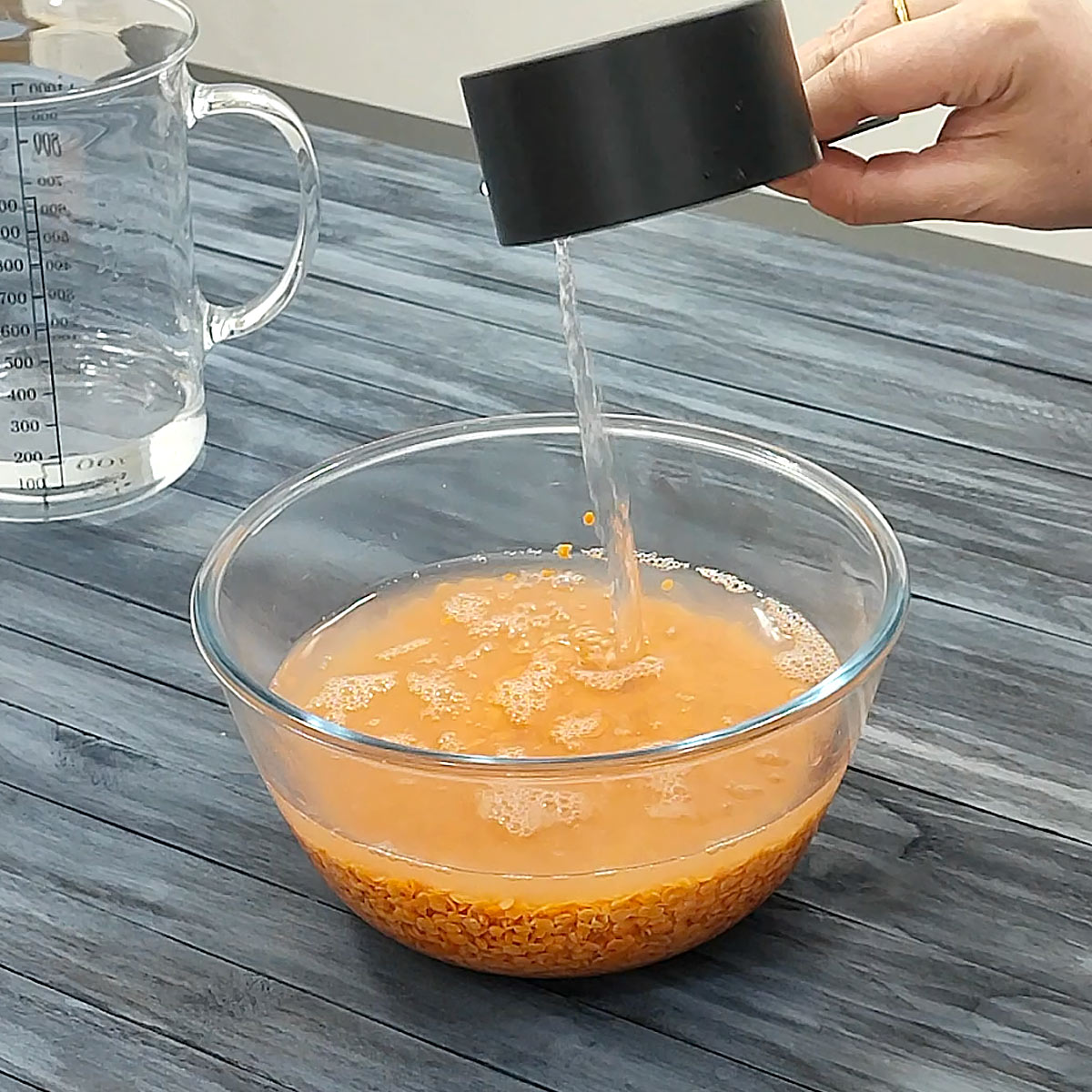
Step 2
Slice onion, dice tomato, slit open green chili and chop fresh cilantro. Keep all the spices and ingredients ready.
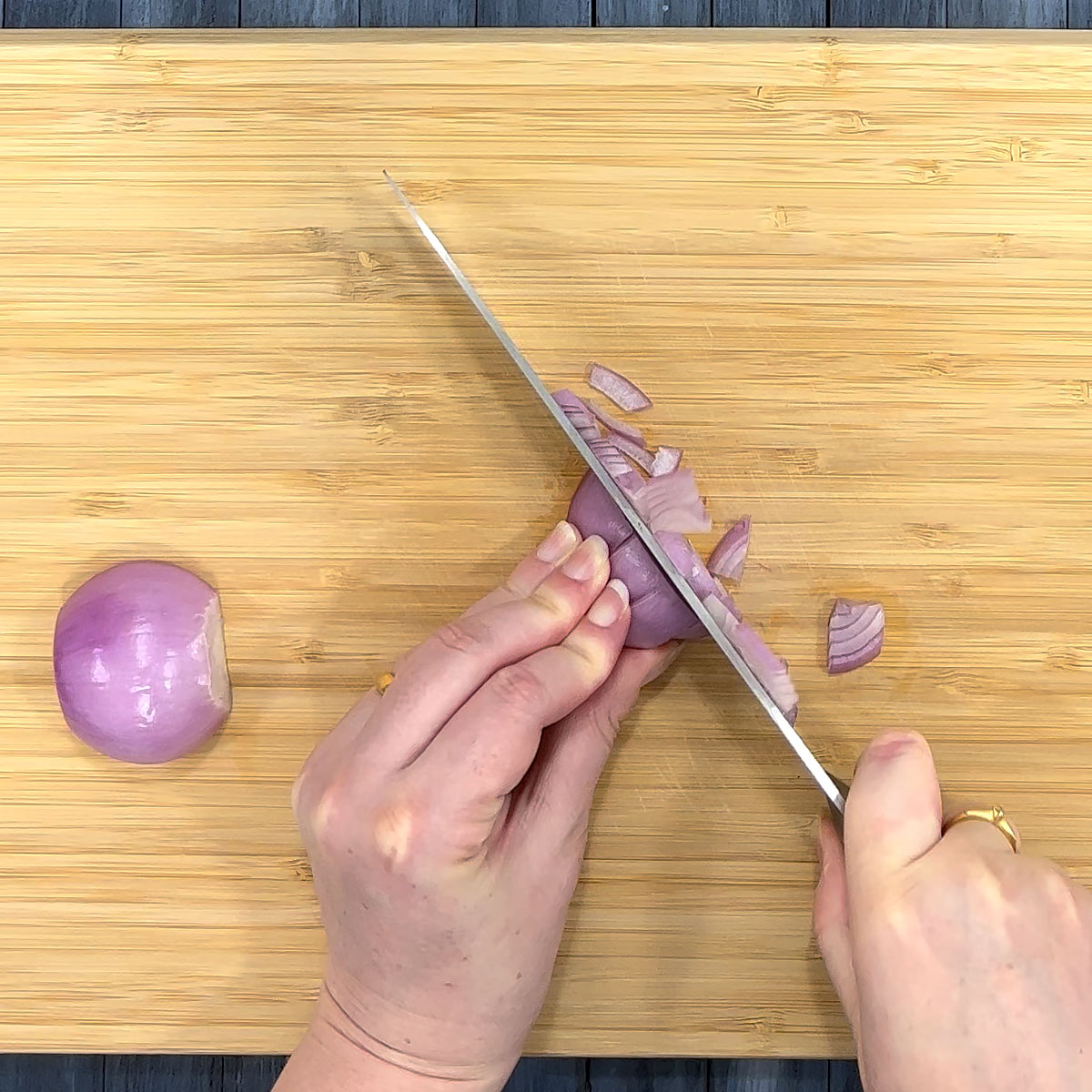
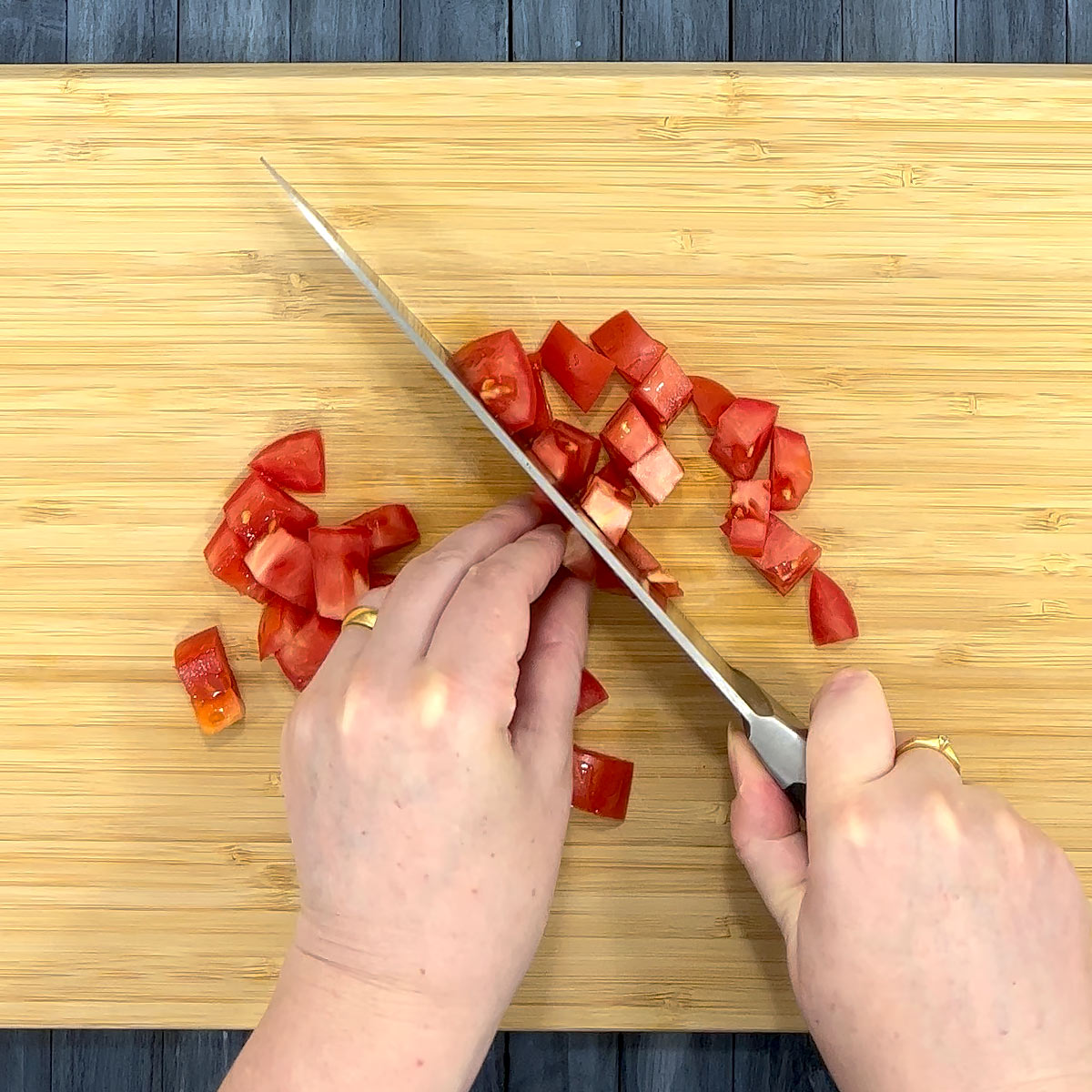
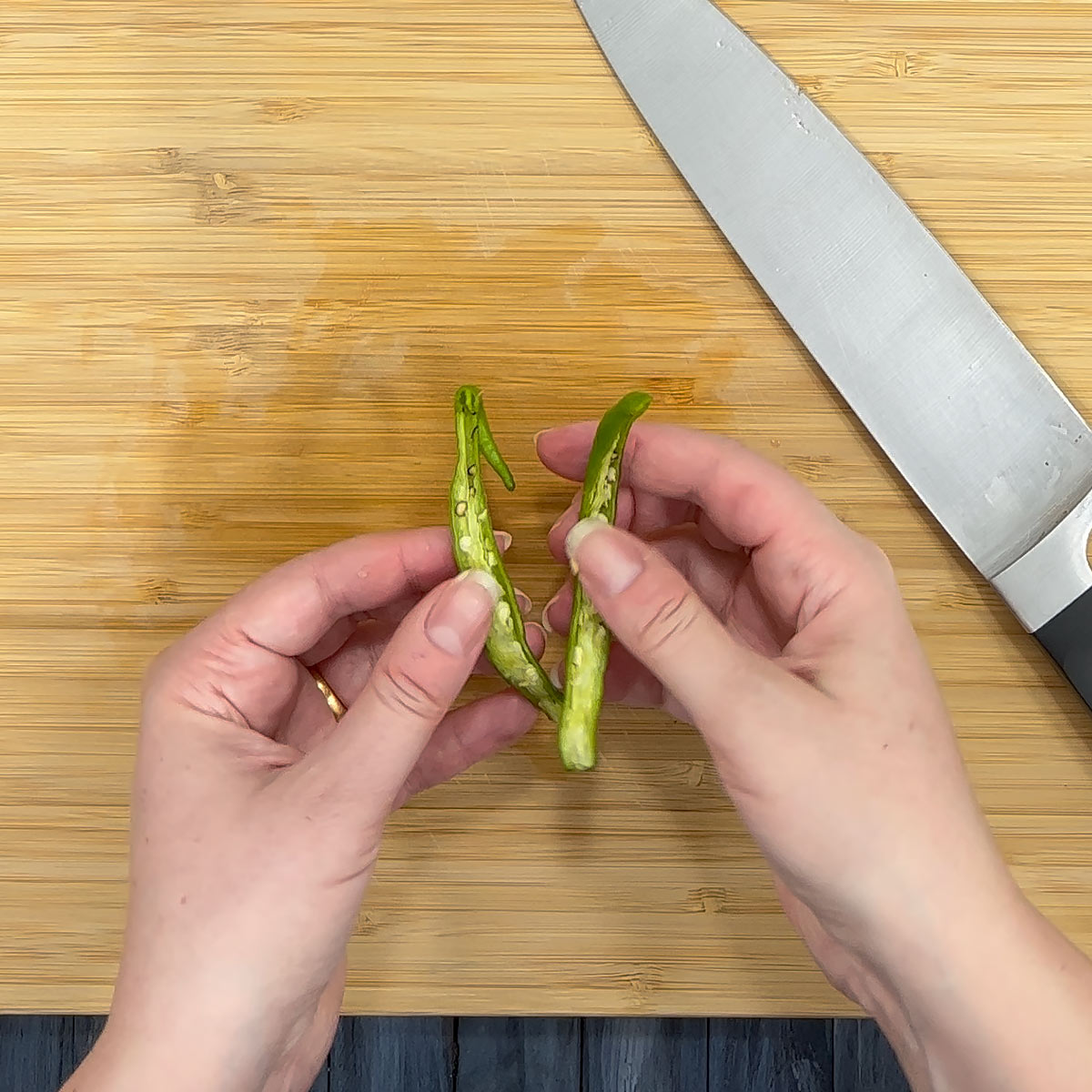
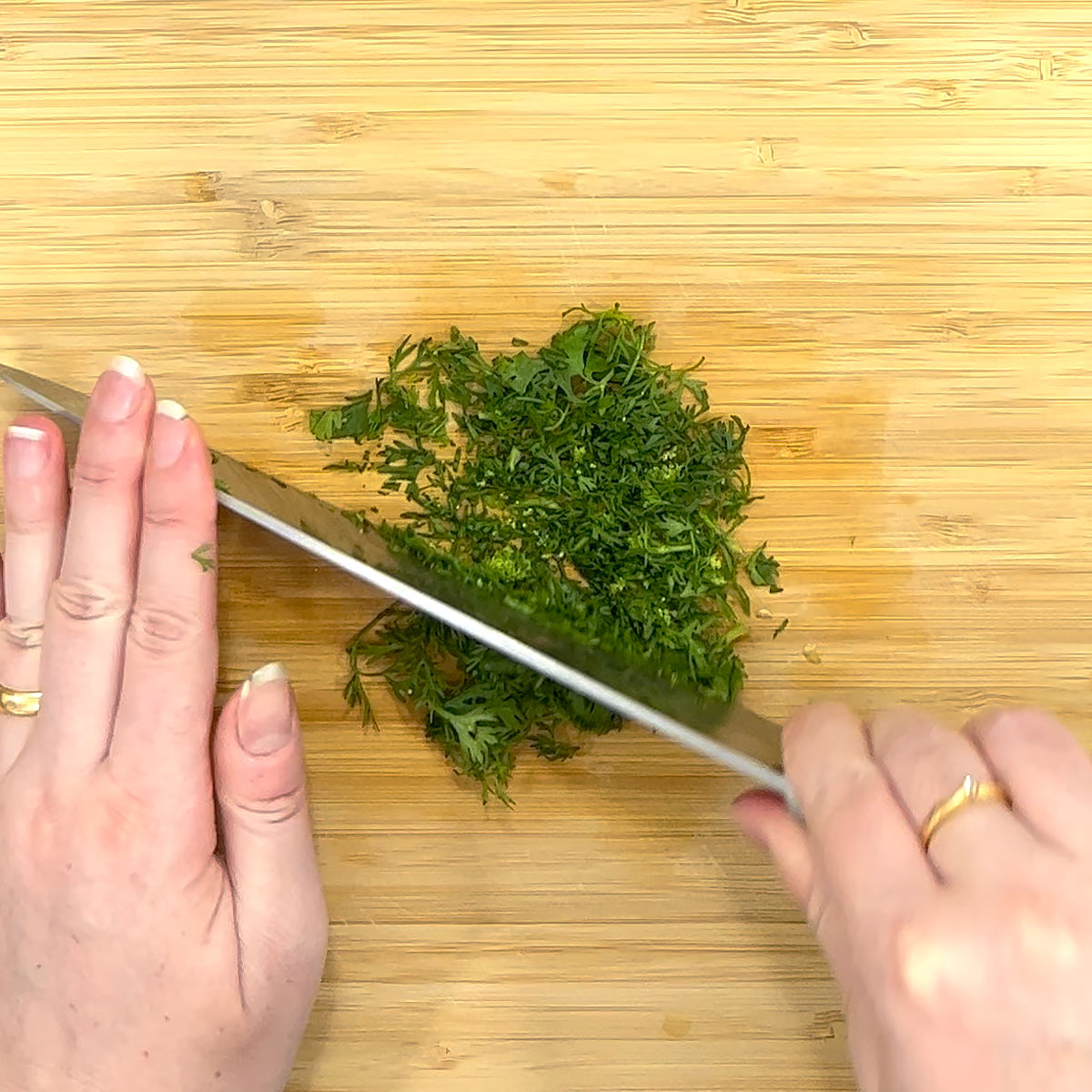
Step 3
Temper spices and sauté vegetables. Control your heat and keep on a lower flame.
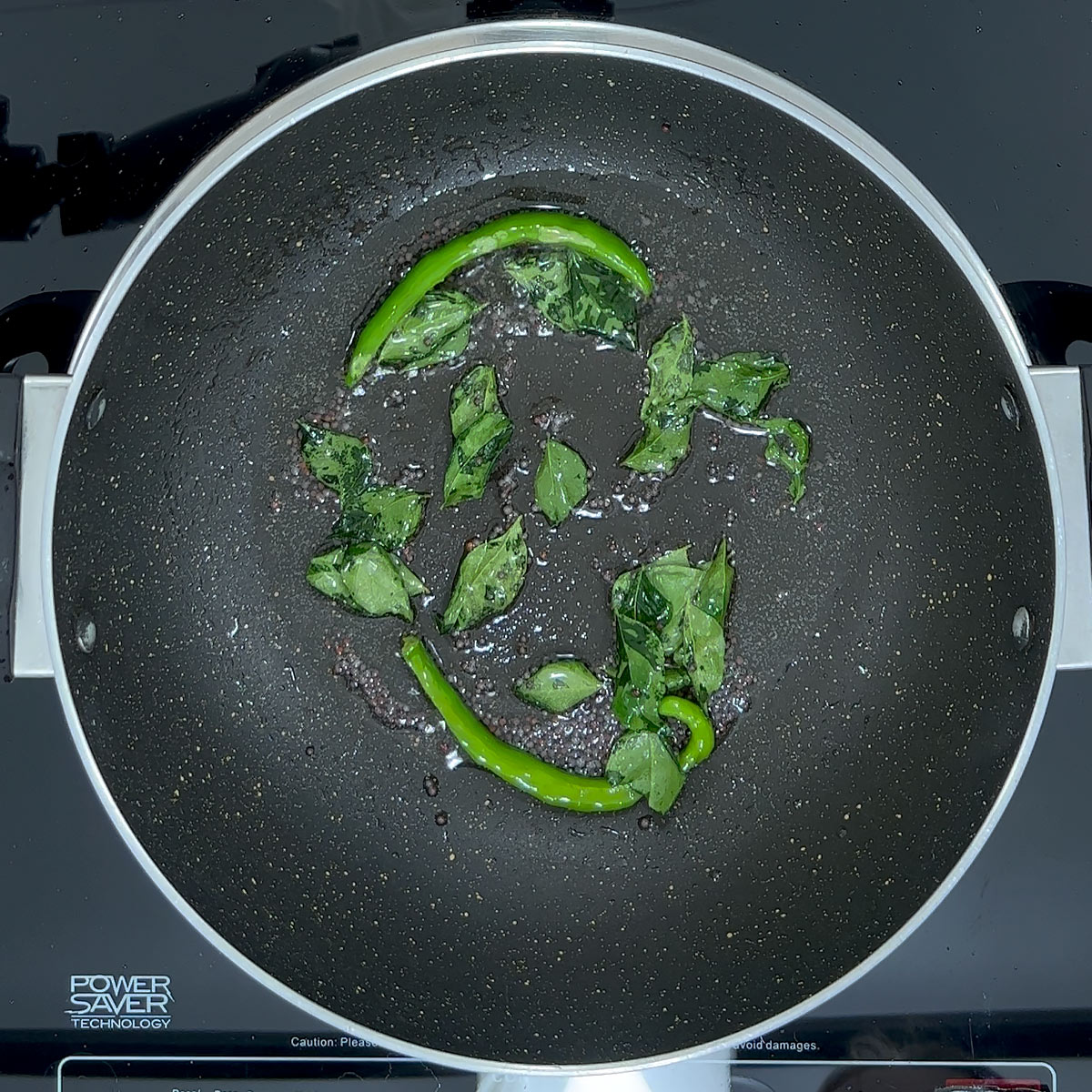
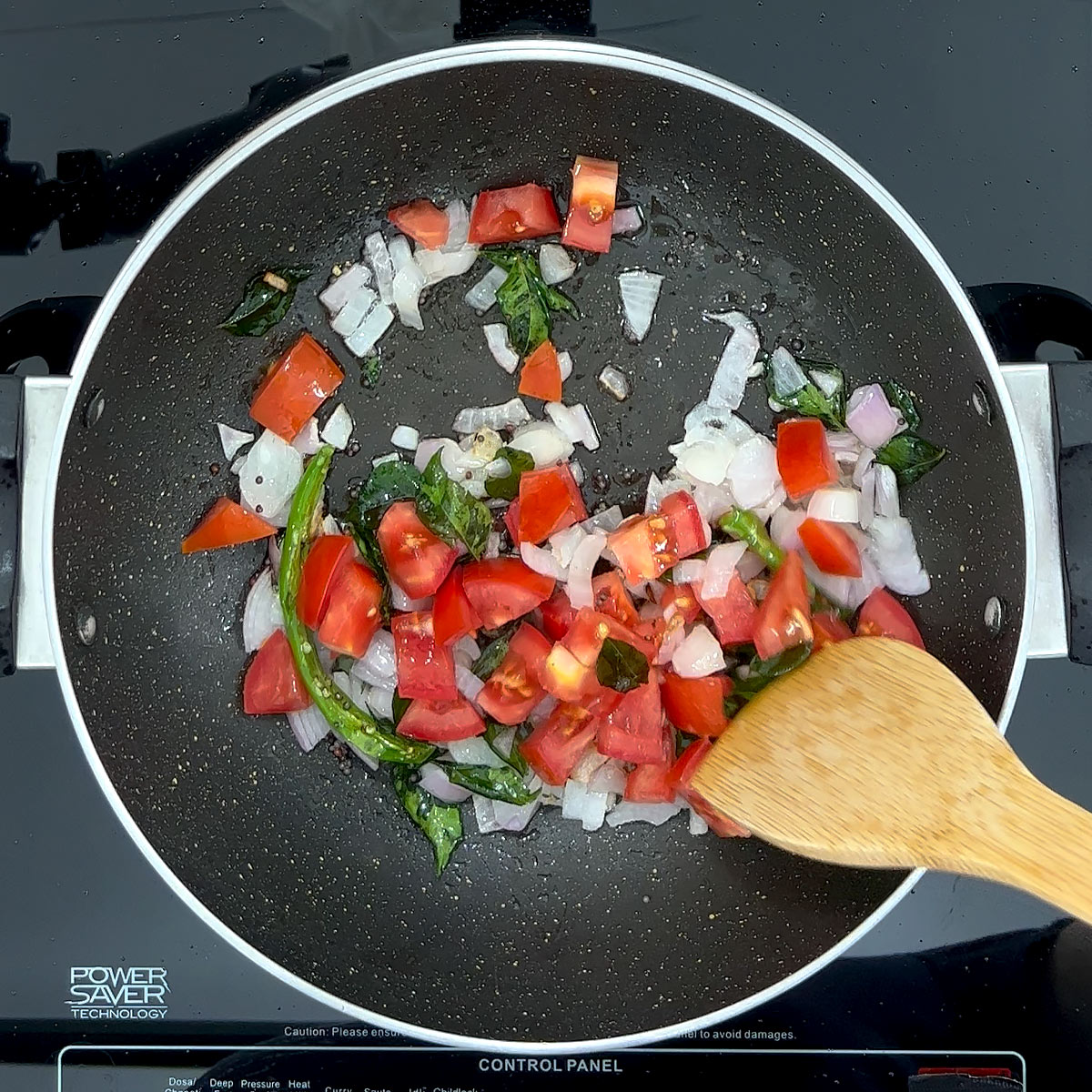
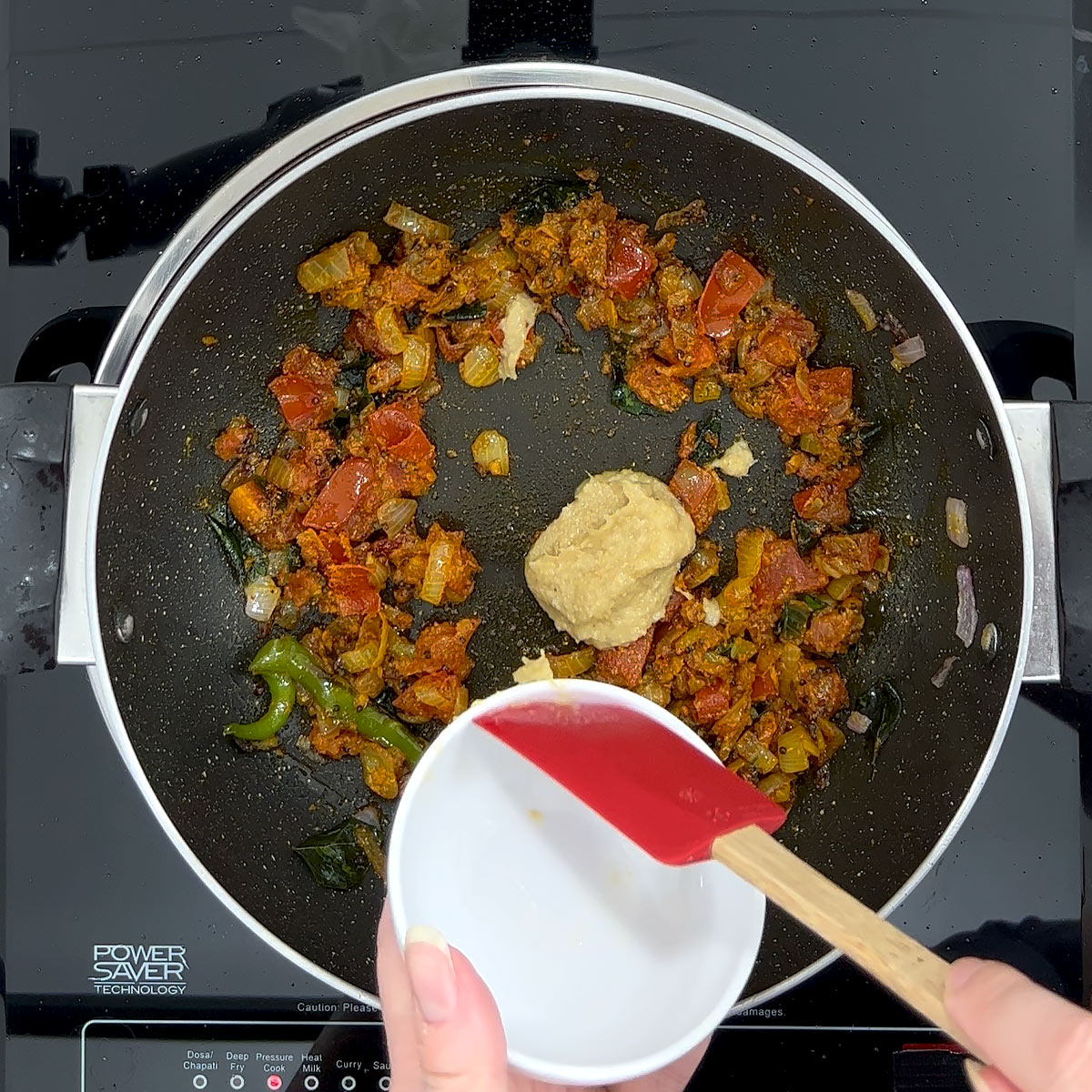
Step 4
Stir in soaked lentils and cover with water. Mix it all well and season with salt.
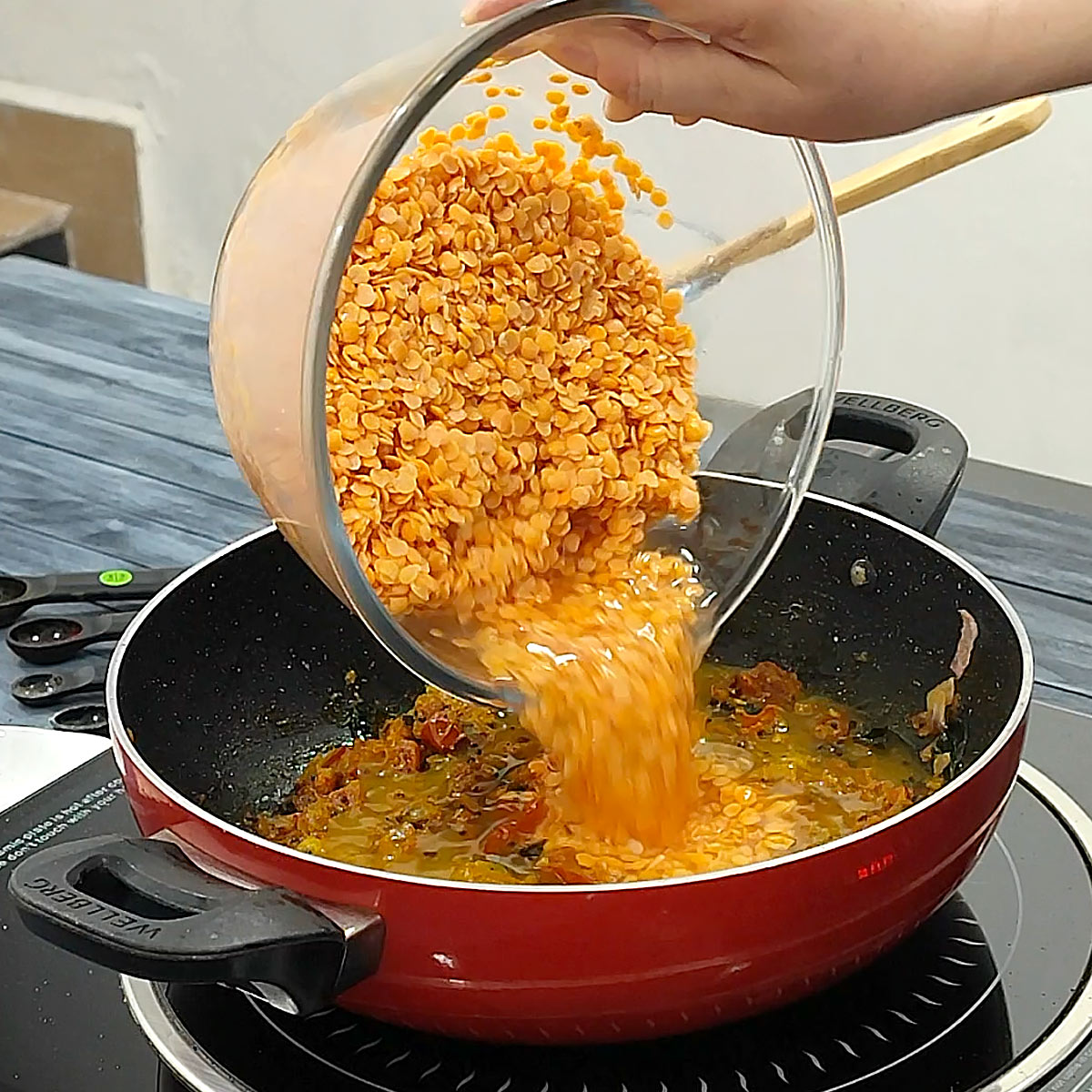
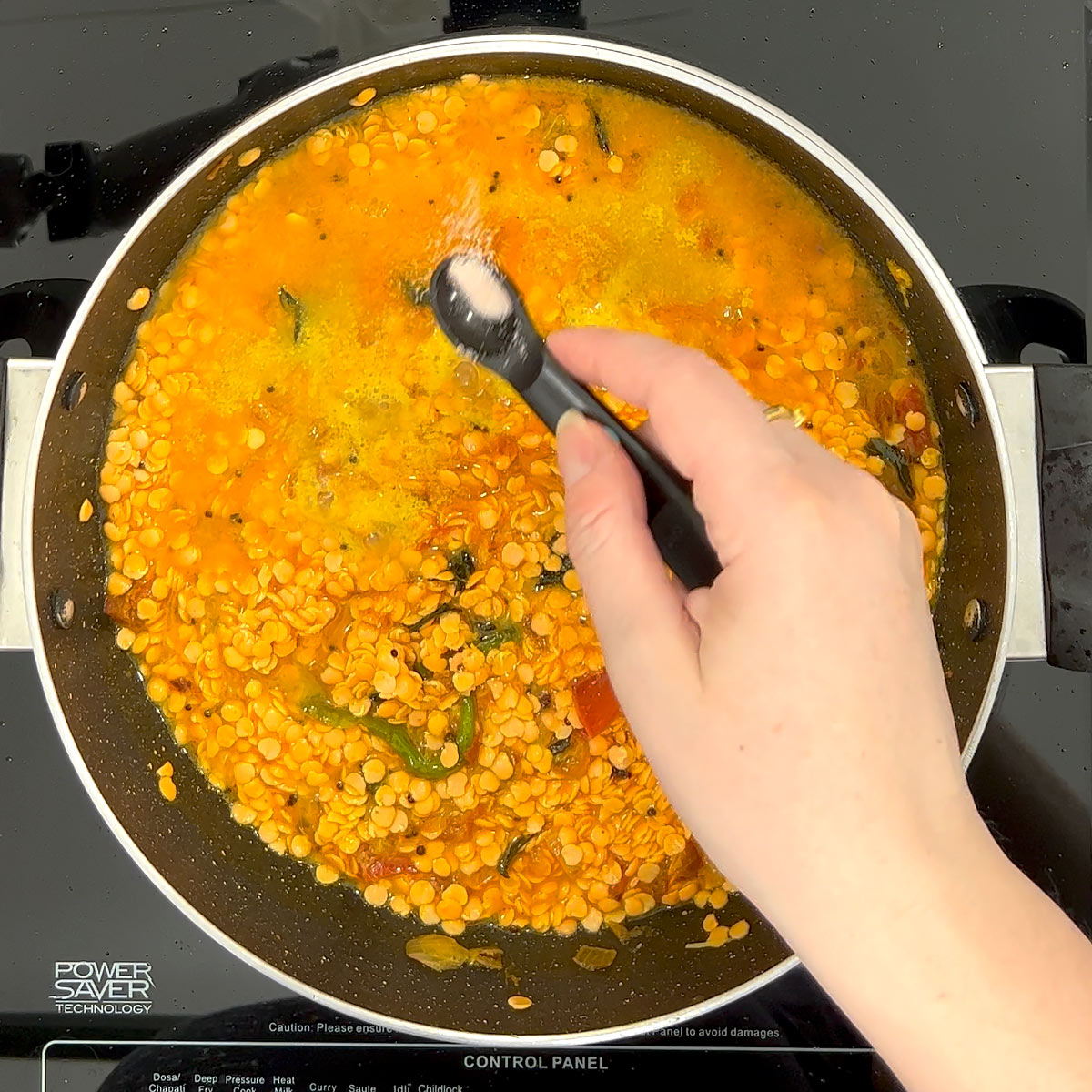
Step 5
Cook lentils over medium heat until they are soft, and you are satisfied with the consistency and flavor intensity.
You can choose to either cook down the lentil dal to a thicker consistency or to keep it more watery. The choice is yours.
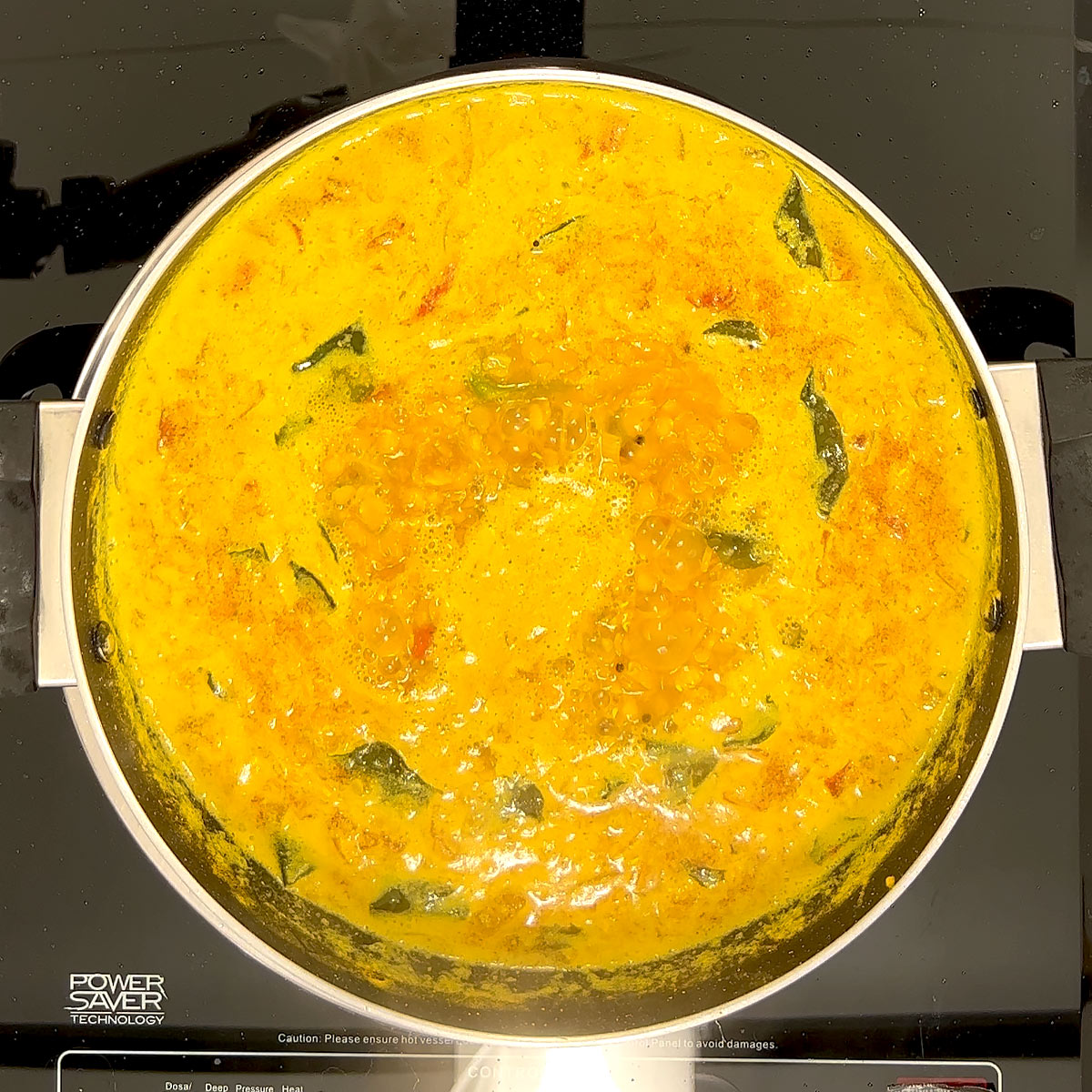
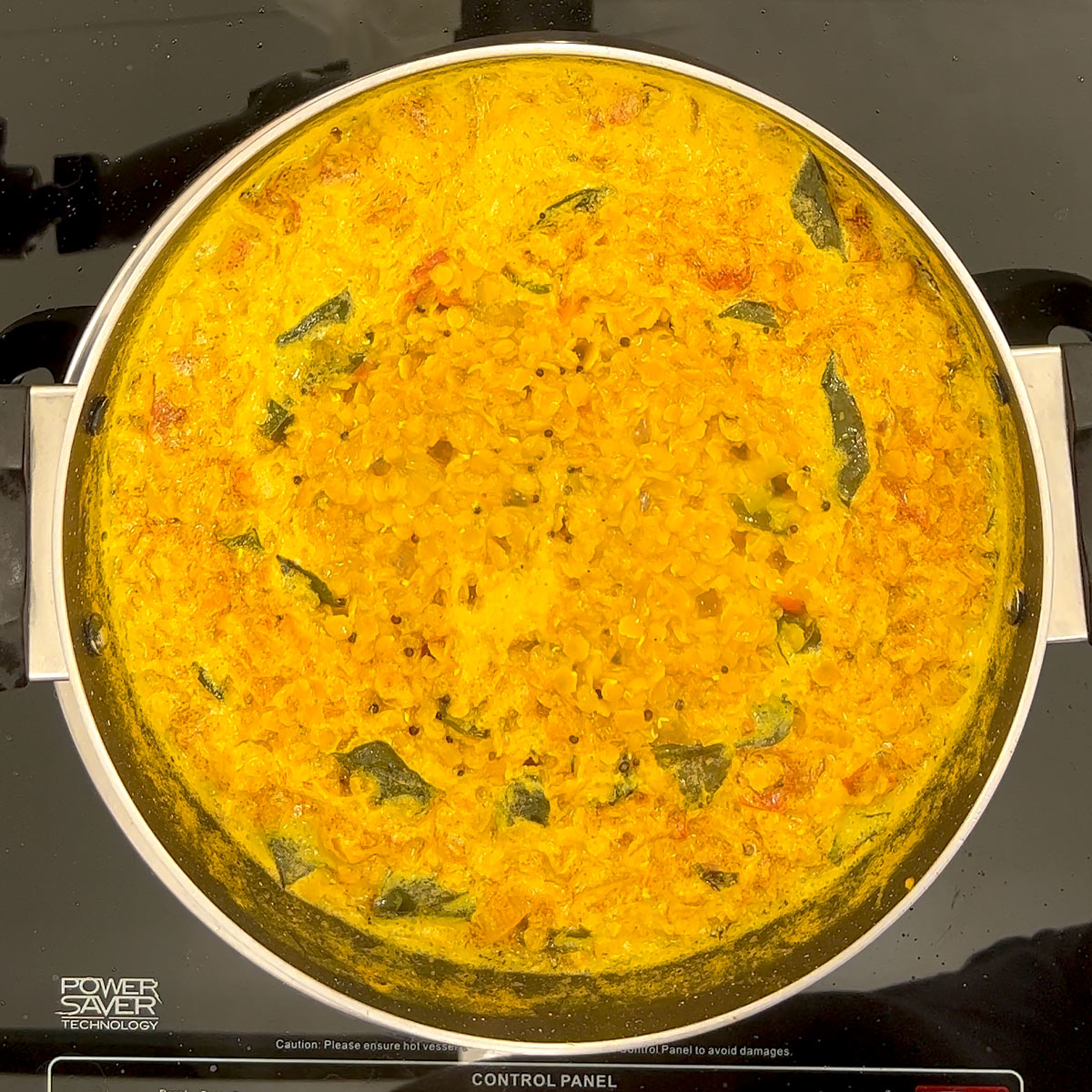
Step 6
Take out the green chili and discard.
Garnish with freshly chopped cilantro and serve hot.
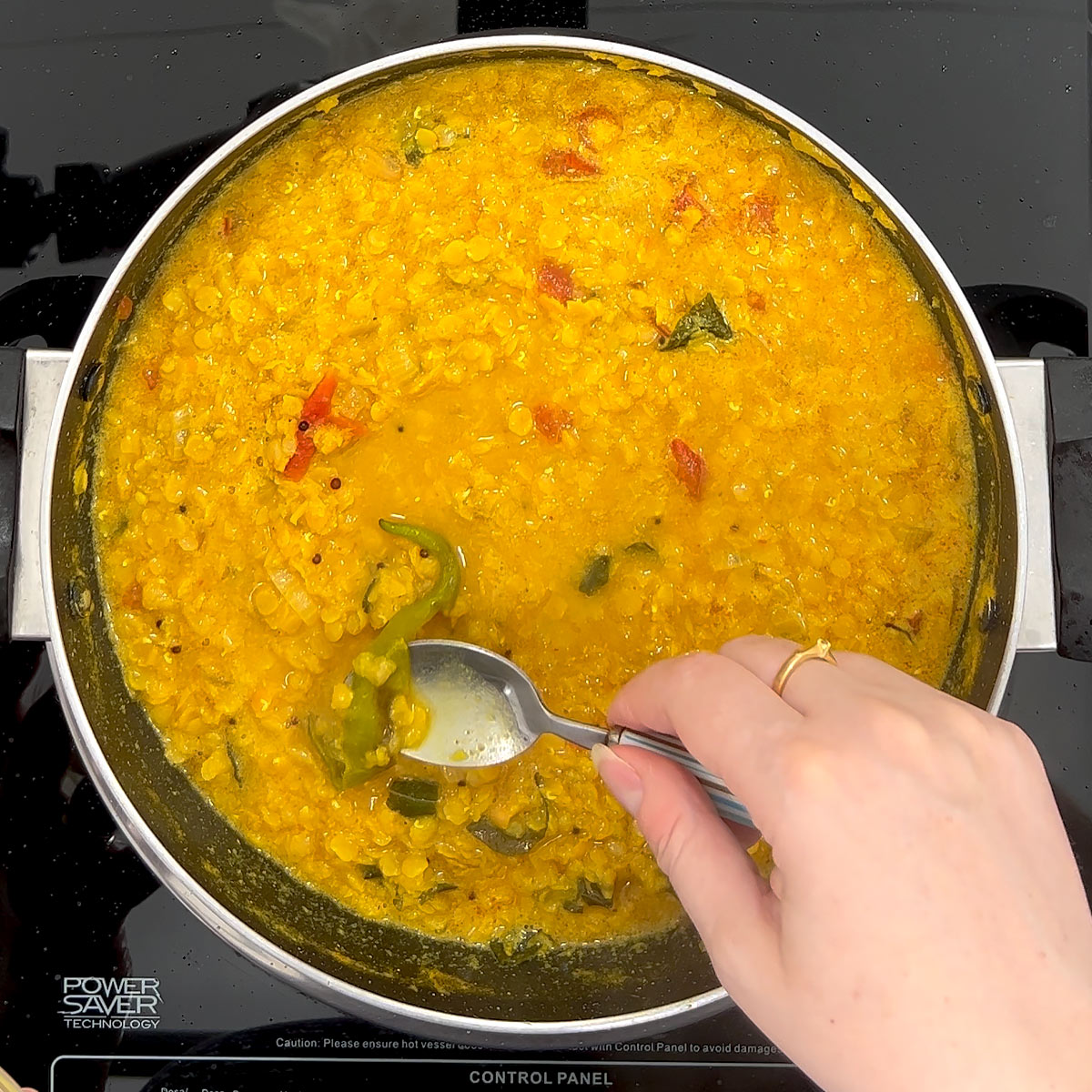
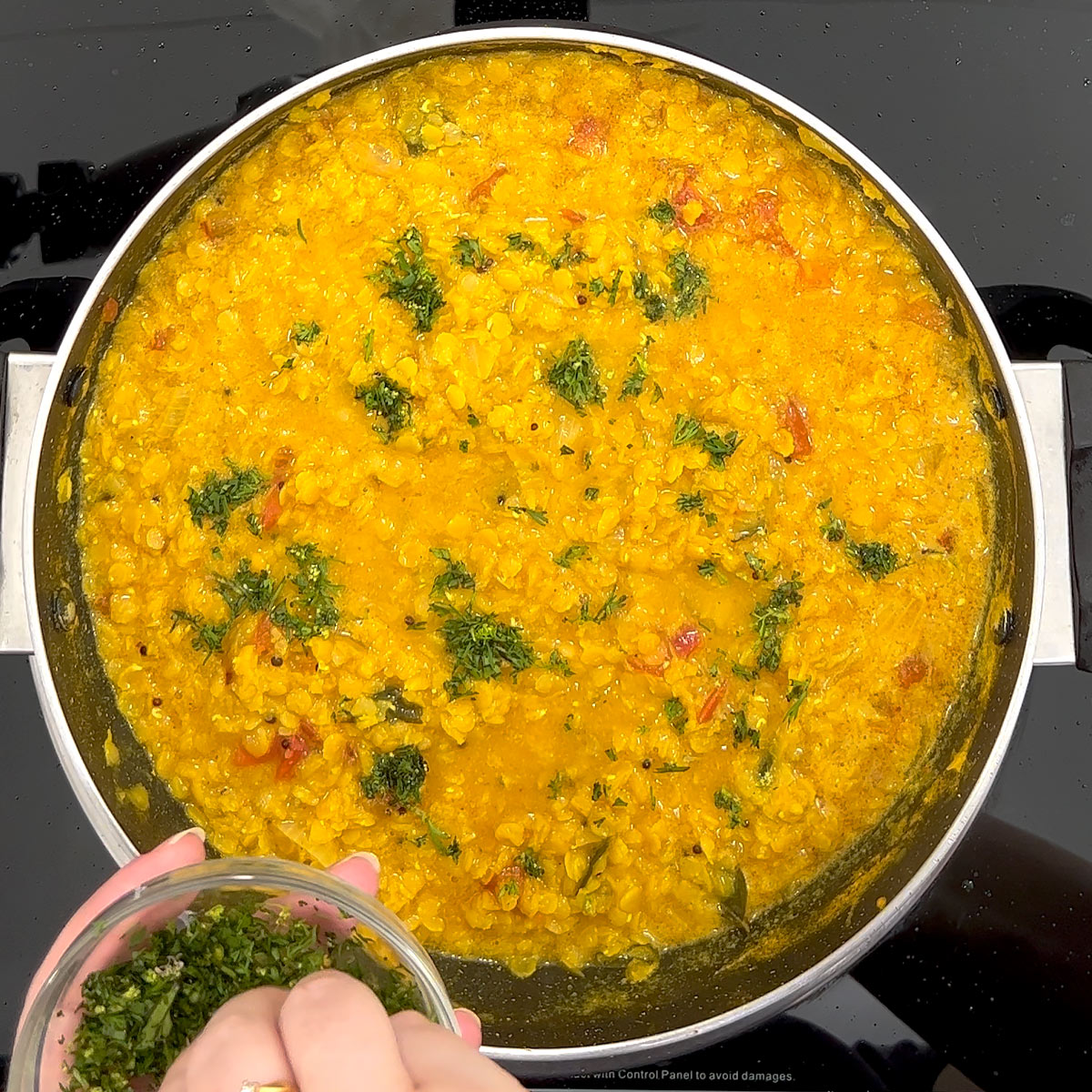
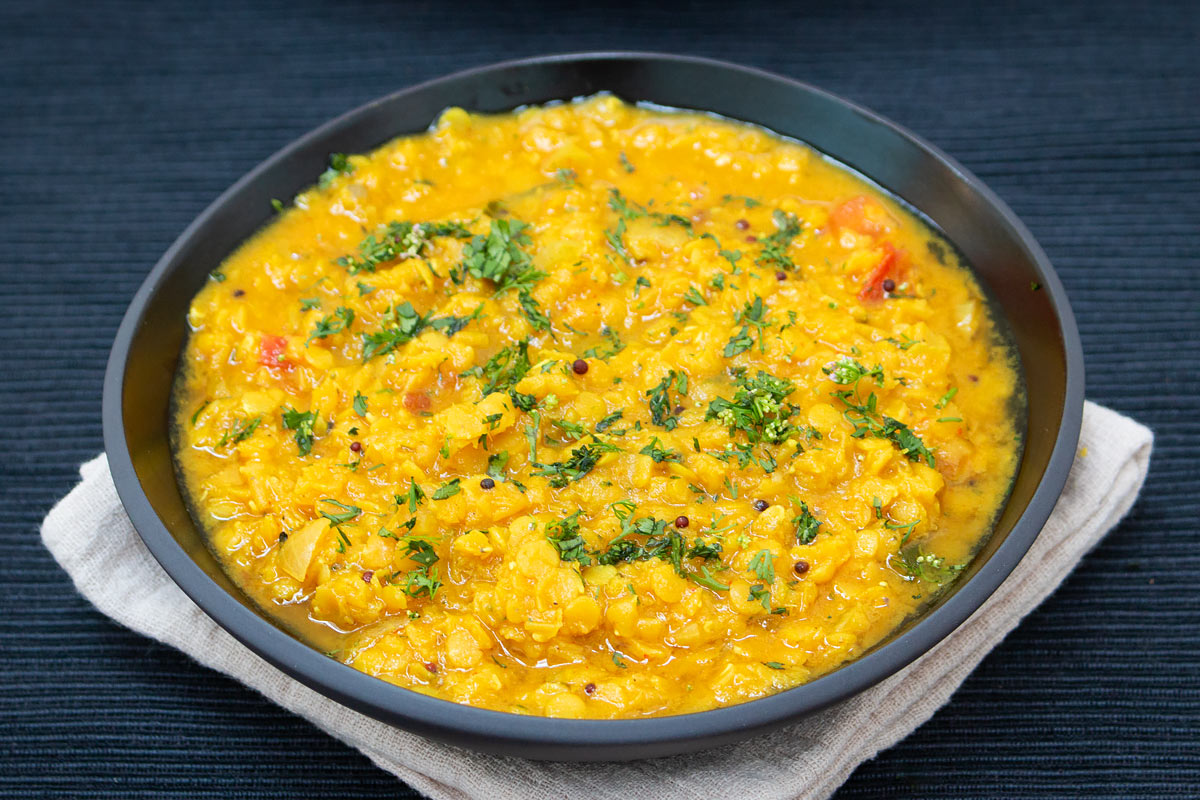
📖 Recipe

Goan Masoor Dal Recipe
Ingredients
To Soak Lentils
- 1½ cup Red Lentils aka Masoor Dal
- Water to top
To Cook Lentils
- 1 medium Onion sliced
- 1 Tomato diced
- 1 Green Chili Pepper optional, I frequently omit this.
- Cilantro Fresh chopped, to garnish
- 2 Tablespoon Oil vegetable, canola, sunflower
- 1 Teaspoon Brown Mustard Seeds
- Curry Leaves a few, fresh
- ¼ Teaspoon Asafoetida aka Hing, optional
- ⅛ Teaspoon Black Pepper
- ½ Teaspoon Cayenne Pepper Ground or red chili pepper (e.g. Kashmiri chili)
- 1 Teaspoon Turmeric Ground
- 1½ Teaspoon Coriander Seeds Ground
- 1½ Teaspoon Cumin Seeds Ground
- 1 Tablespoon Ginger + Garlic I use paste *see Notes
- 1-2 cups Water adjust to your needs
- Salt to taste
Instructions
- Wash lentils in fresh water repeatedly until the water is clear.1½ cup Red Lentils, Water
- Cover dried masoor lentils with water and soak for 10–20 minutes.
- Prep vegetables. Slice onion, dice tomato, slip green chili open lengthwise and also keep the freshly chopped coriander ready, which you will need to garnish the dish.1 medium Onion, 1 Tomato, 1 Green Chili Pepper, Cilantro Fresh
- Keep fresh clean curry leaves ready and all the other spices and ingredients as well.
- Keep your pan over a lower heat setting and pour in oil. Wait for the oil to get a bit hot. Once hot stir in mustard seeds, green chili and fresh curry leaves to temper them briefly (careful, mustard seeds jump when the oil and pan are too hot). I temper for less than a minute in the hot oil because I don't want the mustard seeds to turn bitter.2 Tablespoon Oil, 1 Teaspoon Brown Mustard Seeds, Curry Leaves, 1 Green Chili Pepper
- Stir in the sliced onion and sauté over a medium-low heat setting for a minute. Stir in diced tomatoes and sauté covered until the tomato turns a bit soft.1 medium Onion, 1 Tomato
- Reduce the heat and make some space in the center of the pan to drop in the ground spices to temper lightly (this releases all essential oils and flavors). Add one by one, the asafoetida, ground black pepper, ground red chili pepper/cayenne, turmeric powder, coriander seed powder and ground cumin. Stir-cook briefly and control the heat.¼ Teaspoon Asafoetida, ⅛ Teaspoon Black Pepper, ½ Teaspoon Cayenne Pepper Ground, 1 Teaspoon Turmeric Ground, 1½ Teaspoon Coriander Seeds Ground, 1½ Teaspoon Cumin Seeds Ground
- Make some space again at the center of your pan and stir in ginger garlic over a lower heat setting (careful, the paste jumps when the pan is too hot).1 Tablespoon Ginger + Garlic
- Stir in soaked red masoor lentils and pour in extra water and a pinch of salt.1½ cup Red Lentils, 1-2 cups Water, Salt
- Cook on a medium heat setting for about 15 to 20 minutes, or until done, and you are satisfied with the consistency, stirring occasionally so that nothing burns on. If you feel your masoor dal needs more water, then just add a little more to adjust the dish consistency (sometimes depends on the quality and age of the lentils).
- Adjust salt seasoning.Salt
- When done cooking, take out and discard the green chili pepper. The curry leaves can be left in the masoor dal as they are edible, but you can take them out if you don't like chewing on leaves (this is why I use young tender leaves only).
- Garnish with chopped fresh cilantro (Coriander)Cilantro Fresh
Notes
Equipment
- 8" Chef Knife
Nutrition
Serving
Traditional Use
We generally enjoy this Masoor dal at home with cooked rice. We avoid white rice and prefer brown rice. In Goa, they use a brown rice variety that they call Goa rice or fat rice. It's the same one used in the Congee rice recipe.
Masoor dal curry can be part of an Indian Thali (a platter consisting of various small quantities of dishes).
Additionally to the rice, most Goans usually prepare it with a dried marinated mackerel pickle, which is known as Parra, during the rainy season in July and August. The combination of pungent red cured fish goes really well with masoor dal.
They also like pickled shrimp such as prawn mol or dishes infused with recheado masala paste, such as recheado stuffed okra, with this Masoor dal.

How I Serve It
For lunch, I have my masoor dal with some brown Goan rice and I add a Goan vegetable side dish to that, such as Ivy Gourd (Tendli bhaji) or okra flavored with kokam spice (Ladyfinger bhaji).
Then I pour some unconventional Vinaigrette dressing over all that, and that's my take on this dish.
We also like to pan fry some eggs, either plain or some recheado masala or a masala paste leftover from the parra fish or mol pickle. Or I also drop an egg into the dal while it's almost done cooking.
Storing
I like to prepare a larger quantity, which I then batch into smaller quantities and freeze in freezer-friendly containers.
Masoor dal tastes even better days later when you warm it up again! Making it a great leftover dish. Keep leftovers in a fridge friendly container for up to 4 days.
To reheat fridge cold or frozen dal, place into a pan and keep over a slow heat setting. Stir occasionally and serve hot.
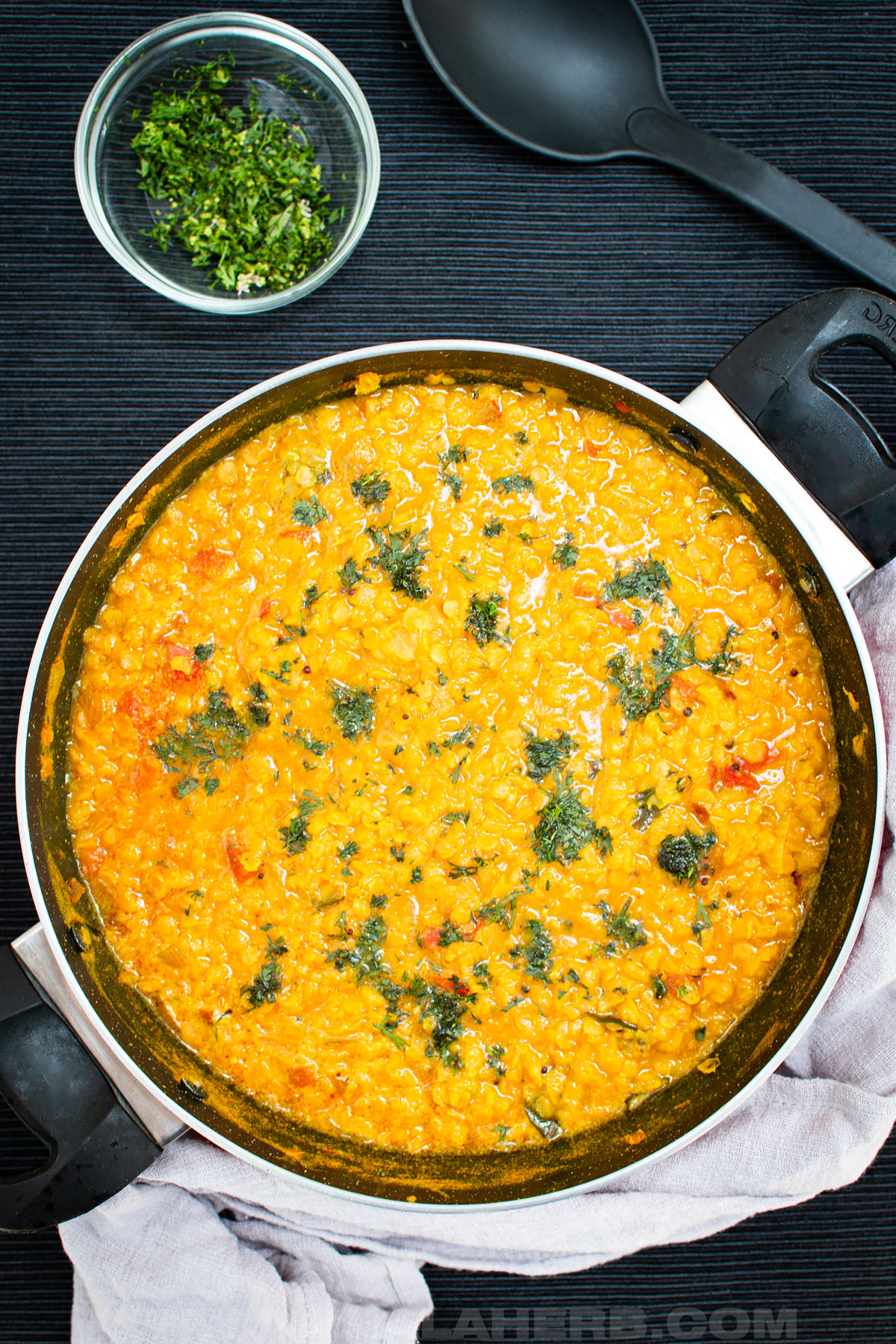
FAQs
Yes! Masoor dal split (red/orange lentils) are easily digested, and these lentils contain less fiber than other lentil varieties, which makes them easier to digest. Perfect for babies older than 9 months. Reduce the spices and omit the chili, and purée the red lentils for baby consumption. Indian babies are given spicy food too, so you can try feeding your baby with a minimal amount of spice such as turmeric and coriander.
Split Pigeon Peas (toor dal) and Khesari Dal are yellow and resemble masoor dal. Masoor dal is always orange-red in stores.
More Recipes like that
- Aloo Gobi — Potato Cauliflower Curry.
- Snake Gourd Stir Fry — Great to add to your thali.
- Chapati ghee flatbread.



Only 1 person in all the comments has actually cooked this dish!!!
How on earth can you give a 5 star rating when you have never cooked or even tasted the food?!
Hi Andy,
When the star rating came out a few years ago, folks liked to rate and I wouldn't stop them, because it's a personal choice.
Over time I have been going through thousands of comments on this website to remove ratings that were not justified. This website has been around since 2011 and this is one of the earliest recipes that I shared.
I understand your frustration and I do agree with your point of view. We shouldn't forget that others see it differently and this space has always been open towards multiple point of views and how they use their stars. I hope you understand. If you get a chance to try the recipe, I invite you to leave us a star rating. It would most definitely help others in their quest to find delicious food. Besides, readers like to take a picture of the dish and share it on the pin on Pinterest.
The first blog posts in my blog, way back in 2007, had very bad pictures too 🙂
Dal looks very delicious and easy to prepare too. Will try sometime and let you know 🙂
I haven't soaked red lentils either but I'm going to try it when I follow your recipe.
Are you back in Goa??
Happy New Year!
Love red lentils! I'm with Eva -- I rarely soak mine, either. But I should try it, and see if it makes a difference. Happy New Year!
It's strange that you need to soak the lentils, ours cook up very quickly. I adore the creamy texture of lentils and the spices in this curry sound amazing.
Wishing you and yours a very happy 2017.
Hello! I just made this along with your red spinach stir fry (but wth normal spinach) and they were both DELICIOUS! There were many moans of appreciation from the husband too. I just wanted to say thanks for a wonderful meal - I am looking forward to exploring some more of your recipes!
Glad to know that you and your family enjoyed the dal dish. 🙂
Yeah I know but I strive for perfection 🙂
Thank you so much your support has been a driving factor and has me motivated to do more
Hi Helene, sorry I've been a bit absent recently - so much to do to prepare to move!
I really love the look of this - it totally looks just like something you'd see in a restaurant, especially in that delightful little bowl! Isn't it amazing how serving bowls can really make a difference?
I love lentils in any format - curried though has to be my all time favourite though - I love the texture and "mouthfeel" they take on!
You are perfect, you don't have to strive for it.
I enjoy every recipe you post. On my last comment I posted,
I meant to say "Bless your heart" .
Take care,
Mary M
thank you Mary <3
For me, lentils are comfort food and your delicious preparation sounds yummy 🙂
I see it the same way =)
Thank you!
A good dal dish is always lovely. Hm, it's only quite difficult to get fresh curry leaves around here. I suppose the dried ones are no good.
Hi Chris!
I was told by everyone in Goa that dried curry leafs are not good for dals. But I say if you have no other choice then just go for the dried curry leafs. I know how difficult it can be to find fresh curry leafs in the western world and I have used dried ones at my parents house before. The dal turns out differently if you keep the curry leafs completely out, in fact it takes away the essence of the dal flavors, so it's required anyhow.
I was looking at my first posts today and thinking that I needed to retake a few of the pictures, and yes, the writing style does change. 🙂 No, I have never had Doan Dal. The story behind it is quite interesting and love the looks of it! Reading through the recipe, I can see it's got lots and lots of flavor with all of the spices. Nice post Helene!
Actually you Mj gave me the idea of fixing some old posts. ^.^
Oh I believe you would love the dal, I mean it's your kind of food choice no?
Hi Helene!
I remember when you first starting blogging, Helene. Although your blog has grown, it was never one to apologize for. Now, mine on the other hand, whoo, whoo, it hasn't even gotten that much better. I still talk too much, lol...As a matter of fact, the month of October is my Blogoversary! (we're having a pasta party to celebrate:)
Now, that Lentil Curry looks simply amazing! Your recipes have always intrigued me from beginning to end and when it comes to being a food blogger, isn't that all that really matters:) Thank you so much for sharing, Helene...
There really is nothing to be ashamed of when it comes to our old posts and photos. I think they're great because we can compare to the new ones and see our improvements.:) Your recipe still sounds scrumptious! Thanks for sharing, again, Helene.
We have had that talk in the past, I remember Nancy. You have a good point, at least I feel better when I think how much i have grown and what I have achieved. Thank you so much for your comforting words Nancy. =)
I have some split fava beans. Do you think these might work with this recipe?
hmm I am not sure since I haven't much cooked with Fava beans. If you know how long to soak them maybe you could give it a go no? But he flavors will be different so you might have to adjust and the whole recipe will be a new one. Let me know how it went. 😉
G'day! Your Goan Dhal recipe and photo looks lovely, true!
Nice and warming, welcoming and a winter comfort food...love dhal too!
Cheers! Joanne
Well the dal has for sure some autumn shades. =D Thank you Joanne for your lovely comment.
I have cooked dhal for decades and am glad to have your Goan version as it is slightly different and will be trialled soon. I'll shock you a tad: since I have not used butter [nor poisonous margarine] for a very long time, I actually cook the dhal to a slightly thicker consistency, place it in small ramekins, freeze and use one at a time for a substitute of butter on toast, pita, wraps etc. As long as flavoured a little more than for the hot version, it is absolutely delightful as fusion food 🙂 !
You know this is not going to shock my after what I have seen here at times. Dall is often made into a paste so to be used for fillings which btw is super delicious. In fact you have just given me an idea Eha. Thank you!
I have never tried Goan Dal, but this recipe is going to change that...quickly!
Welcome and enjoy Betsy! 😉
I love dal... it's my favorite dish to eat with rice. 🙂 My kids love it too. 🙂 This was yummy. 🙂
It's so alluring too no Ramona? I think all kids would love this.
This dal looks delicious, and it would be awesome to not have normal 'black dal' everyday 😛
Cheers
CCU
Ha, I thought the same thing when my mum would make the dark dal every Saturday for lunch. ^.^ The orange one is such a lovely lunch pickup.
I can't wait to try this out! Dal is definitely a favorite at our house, and we're always looking for a new one to add to the rotation. 🙂 Hooray!
Enjoy Eileen! I like it with something spicy and sour at the side, such as a pickle. 🙂
I eat lentils all the time, yet I never made a dal recipe. This one goes straight to my to-do list Helene! (so you know, your pics can't be pinned)
Thanks for letting me know Paula.
Not sure what the problem could be with the pin it button on the pictures not working at times. I noticed that it did work earlier for me and somebody else but I had the same problem in the past. Not sure if that works but, if it happens to anybody, just clear your browser cache, that should fix it. Also you could use the social shares underneath each post. There you will find another pin it button where you can choose the picture to pin. Otherwise please let me know if there are any more problems happening in the website experience. Thank you!
I cringe when I look back at those early posts! And I'll probably cringe in a few years (although not as much) when I look back at what I'm doing now — the more one writes or photographs, the better one becomes. Anyway, the recipe is perfection! No need to improve on that, it's wonderful as is. Thanks for this.
Well I think the same way. Most probably I will be looking down at my current posts and feel ashamed, haha! We should remember this and compare later.
I love daal of any kind and Goan version although I have never had it - looks truly delicious.
Welcome and Thank you for sharing Dixya
The lentil looks super delicious and comforting!
You will love it Angie. 🙂
Don't worry, I also dislike the way I wrote and expressed myself before... 😉
That lentil curry looks wonderful and mouthwatering! The kind of dish I love to eat and make.
Cheers,
Rosa
So glad to know I am not the only one feeling this way Rosa. Thanks 😉